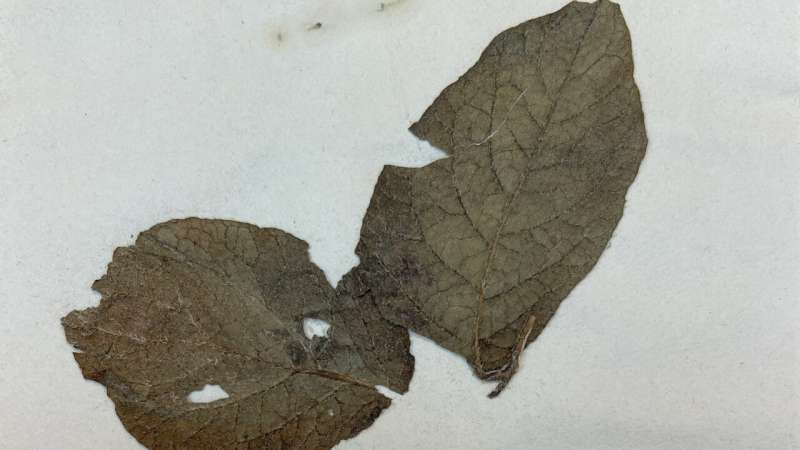This article has been reviewed according to Science X's editorial process and policies. Editors have highlighted the following attributes while ensuring the content's credibility:
fact-checked
peer-reviewed publication
trusted source
proofread
Study analyzes potato-pathogen 'arms race' after Irish potato famine

In an examination of the genetic material found in historic potato leaves, North Carolina State University researchers reveal more about the tit-for-tat evolutionary changes occurring in both potato plants and the pathogen that caused the 1840s Irish potato famine.
The study used a targeted enrichment sequencing approach to simultaneously examine both the plant's resistance genes and the pathogen's effector genes—genes that help it infect hosts—in a first-of-its-kind analysis.
"We use small pieces of historic leaves with the pathogen and other bacteria on them; the DNA is fragmented more than a normal tissue sample," said Allison Coomber, an NC State former graduate student researcher and lead author of the paper.
"We use small 80 base-pair chunks like a magnet to fish out similar pieces in this soup of DNA. These magnets are used to find resistance genes from the host and effector genes from the pathogen."
"This is a first for looking at both potato and pathogen changes at the same time; usually researchers look at one or the other," says Jean Ristaino, William Neal Reynolds Distinguished Professor of Plant Pathology at North Carolina State University and corresponding author of a paper in Nature Communications that describes the study.
"The dual enrichment strategy employed here allowed us to capture targeted regions of genomes of both sides of the host-pathogen relationship, even when host and pathogen were present in unequal amounts. We couldn't have done this work 15 years ago because the genomes weren't sequenced."
The study's results show that the pathogen, Phytophthora infestans, is very adept at fighting off potato late blight disease resistance. For example, the study shows that the FAM-1 strain of the pathogen had the ability to defeat the resistance provided by the plant's R1 resistance gene—even before plant breeders deployed it in potatoes.
"The pathogen would have been able to resist this R1 resistance gene even if it had been deployed years earlier, probably because it was exposed to a potato with that resistance gene in the wild," Coomber said.
The study also shows that many of the pathogen's effector genes have remained stable, although different mutations have occurred to increase its infection prowess as plant breeders attempted to breed resistance—specifically after 1937 when more structured potato breeding programs commenced in the United States and other parts of the globe.
The study also shows that the pathogen added a set of chromosomes between 1845 and 1954, the period of time in which the study's plant samples were collected.
"We show in this work that after 100 years of human intervention, there are some genes that haven't changed much in the pathogen," Coomber said. "They are very stable potentially because they haven't been selected on, or because they are really important to the pathogen. Targeting those genes would make it really hard for the pathogen to evolve an opposing response."
"It's hard to do effective plant breeding when we don't know enough about the pathogen. Now that we know what effectors have changed over time, breeders may be able use resistance genes that are more stable or pyramid multiple resistance genes from different wild hosts," Ristaino said.
"That's where I see the future for this type of study—applying it to slow changes in pathogen virulence or other traits such as fungicide resistance."
More information: Evolution of Phytophthora infestans on its Potato Host since the Irish Potato Famine, Nature Communications (2024). DOI: 10.1038/s41467-024-50749-4
Journal information: Nature Communications
Provided by North Carolina State University


















